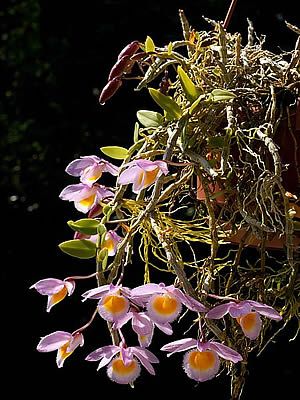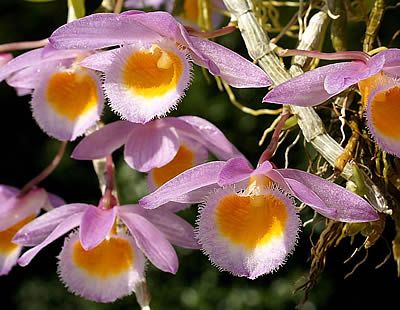The Loddiges’ Dendrobium (Dendrobium loddigesii) is an oriental orchid, deciduous, with delicate flowers that contrast with the tangle of pseudobulbs. It is native to tropical forests at altitudes between 1000 to 1500 meters (3281 to 4921 feet) in China, Laos, and Vietnam, where it thrives as an epiphyte or lithophyte in mossy and highly humid locations.
It was first described in 1887 by the English botanist and orchidologist Robert Allen Rolfe, known for being the first curator of the orchid and herbarium collection at the famous Royal Botanic Gardens in Kew. The plant’s name is a tribute to Joachim Conrad Loddiges, a renowned English collector, horticulturist, and botanist.
Growing sympodially, this orchid has a compact rhizome, produces many aerial roots, and has thin, grooved, caniform, recurved, and pendant pseudobulbs, which, as the plant grows, form a true tangle. The leaves are small, elliptical to lanceolate, and accompany the new pseudobulbs. In autumn and winter, the plant sheds most or even all of its leaves, then blooms, already bare, in late winter and early spring.
The flowers appear at the nodes of the pseudobulbs and are large, about 5 centimeters (2 inches) in diameter, pink, with a more intense lip color, a vibrant yellow center, and finely fringed edges. The flowering lasts approximately 15 days. After flowering, the plant will start to sprout new pseudobulbs that will bloom the following year.

With a mild fragrance, and such striking flowers, the Loddiges’ Dendrobium is highly desired by collectors and orchid enthusiasts. Due to its fast growth and ease of cultivation, it is suitable for both beginner and advanced gardeners. The cascading set of flowering pseudobulbs forms beautiful clusters on older plants.
It can be planted directly on trees, tied with raffia or other biodegradable materials, or even on boards and pots made of fiber, clay, or plastic, preferably designed for orchids. Due to its durable flowers, it is also used in floral arrangements, such as centerpieces and bouquets.
It should be grown in partial shade or shaded areas, between 40% and 50%, in well-draining substrate with good moisture retention capacity, suitable for epiphytic orchids, and watered regularly. Watering should be reduced or suspended when the plant is devoid of leaves.
It prefers mild temperatures, with warmer days and cooler nights. Fertilize every 15 days during growth and flowering with organic or chemical fertilizers designed for orchids and for that specific period. Repot before the guide shoots no longer have space to grow and develop new roots in the substrate.
Propagation is done by separating the pseudobulbs, leaving the new plant with a complete structure of 4 to 5 pseudobulbs connected by the rhizome and a guide shoot. It can also be propagated by dividing mature pseudobulbs.


